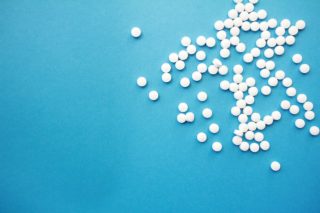What Causes Oxycodone Addiction?
There are many reasons why so many people struggle with oxycodone abuse, dependence and addiction.
How Does Oxycodone Work?
First, it’s important to understand how oxycodone and similar opioids work. These substances increase dopamine in your brain, which may create pleasant sensations. When you take a high dose of oxycodone, you may enter a state of euphoria (also known as a “high”).
If you want to repeat the experience, you will need to take more oxycodone. Over time, your body may adjust to your current dosage of oxycodone. To feel the same effects, you will need to take more of the drug, which often leads to drug abuse.
Even people who take oxycodone as prescribed are at risk of physical dependence or addiction. While the prescribed dosage may initially have the intended effect (e.g. pain relief), your brain may adjust to this dose. Once the medication is no longer effective at relieving pain, you may feel tempted to take an additional dose or increase your dose without a doctor’s approval.
Sometimes, patients return to the doctor’s office and ask for a larger dose or prescription refill. The doctor becomes concerned that the patient is abusing the drug and refuses to prescribe additional medication. At this point, the patient may cease the drug altogether, which may cause withdrawal effects. Alternatively, some people seek oxycodone via illegal methods, which can lead to additional substance abuse problems later.
Of course, not everyone becomes addicted to oxycodone via prescription usage. Some people start taking oxycodone recreationally (and illegally) in an attempt to get high.
Types of Oxycodone Abuse
Any of the following situations are considered oxycodone abuse:
- Taking oxycodone without a prescription. This may include taking someone else’s prescription or purchasing oxycodone “on the streets”
- Taking oxycodone for its euphoric effects (aka to get “high”)
- Taking oxycodone more frequently than prescribed
- Taking higher doses of oxycodone than prescribed
- Taking oxycodone other than directed (e.g. crushing, snorting or injecting an oral prescription)
If you’re taking oxycodone exactly as prescribed but you are concerned about the side effects or risk of addiction, please contact your doctor. If you’re abusing your medication or worry that you’ve become dependent on oxycodone, there are treatment options available. Contact Windward Way Recovery for more information.
What Is Oxycodone?
Oxycodone is a prescription medication used for pain relief. It’s partially synthetic.
Brand names of oxycodone include:
- OxyContin
- Percocet
- Roxicodone
- Xtampza ER
Each of these brands is a different formulation that includes oxycodone as an active ingredient. Some of these medications include other active ingredients, too.
Oxycodone is labeled a Schedule II controlled substance by the United States Drug Enforcement Administration (DEA).
Oxycodone relieves pain by binding to opioid receptors, which changes the way the brain interacts with the body. Because it is a Schedule II drug and based on the way it works, oxycodone has a high potential for dependency and abuse. However, it is also effective as a medication for its intended purpose, and your doctor may decide that the benefits outweigh the risks (or vice versa).
If you worry that you have become dependent on oxycodone or may be abusing your medication, please seek help immediately. Windward Way Recovery can help you start your recovery today.
Signs of Oxycodone Abuse or Addiction
When someone abuses a drug like oxycodone, they may try to hide the problem. However, medical professionals are trained to notice the signs and symptoms of opioid addiction.
If a patient has a prescription for oxycodone for pain management and begins abusing the medication, they may:
- Claim that the pain is worse even though the other symptoms of their illness or condition are much better.
- Ask for a higher dosage of the medication.
- Ask for early or additional refills of their medication.
- Claim they lost their medication or that it was stolen.
- Seek treatment at various clinics, hospitals or physician offices to obtain more medication.
- Demonstrate physical signs of opioid withdrawal during examinations.
If the signs are clear, a doctor might diagnose the patient with opioid use disorder (aka oxycodone addiction).
What Is Opioid Use Disorder?
Opioid use disorder (OUD) is also known as opioid addiction. It is a chronic illness that includes repetitive misuse of opioid drugs and certain behaviors associated with seeking more opioid drugs.
According to the American Psychiatric Association, signs of opioid abuse disorder include:
- Taking larger amounts or taking drugs over a longer period than intended.
- Persistent desire or unsuccessful efforts to cut down or control opioid use.
- Spending a great deal of time getting or using the opioid or recovering from its effects.
- Craving, or a strong desire or urge to use opioids
- Problems fulfilling obligations at work, school or home.
- Continued opioid use despite having recurring social or interpersonal problems.
- Giving up or reducing activities because of opioid use.
- Using opioids in physically hazardous situations.
- Continued opioid use despite ongoing physical or psychological problems likely to have been caused or worsened by opioids.
- Tolerance (i.e., need for increased amounts or diminished effect with continued use of the same amount).
- Experiencing withdrawal (opioid withdrawal syndrome) or taking opioids (or a closely related substance) to relieve or avoid withdrawal symptoms.
A diagnosis of opioid use disorder requires several of these signs as well as other symptoms and behavioral changes that indicate opioid misuse is a problem.
Oxycodone Withdrawal Symptoms and Management
Those affected by opioid use disorder usually exhibit signs of physical dependence. Once the body adjusts to recurrent opioid use, the person may experience negative side effects when they stop taking the medication. That is one of the factors that makes it so difficult to recover from opioid use disorder without professional assistance.
These symptoms may vary from mild to severe, and they may occur whenever the body metabolizes all the oxycodone.
A medical detox program like Windward Way Recovery helps patients minimize or eliminate opioid withdrawals through supportive treatment options and alternative medication options. These services are often the difference between a successful recovery attempt versus a relapse.
Oxycodone (OxyContin) Withdrawal Symptoms
The most common signs of OxyContin or Percocet withdrawal include:
- A restless sensation.
- Tiredness.
- Excessive yawning.
- Runny nose.
- Sweating.
- Chills.
- Muscle aches.
- Watery eyes.
- Dilated pupils.
While less common, other possible symptoms of oxycodone withdrawal include:
- Anxiety.
- Insomnia.
- Increased heart rate.
- Increased blood pressure.
- Back or joint pain.
- Stomach cramps.
- Diarrhea.
- Nausea.
- Vomiting.
Sometimes these symptoms are more severe depending on the person’s level of physical dependence. However, that isn’t the only factor that affects the severity of symptoms. The person’s other health conditions and medical history may create more or less severe symptoms.
When Does Opioid Withdrawal Begin?
Withdrawals start at different times for different drugs. Oxycodone formulations are usually short-acting medications. Withdrawals may start as soon as eight hours after your last dose. They may also start up to 24 hours after your last dose. Symptoms usually resolve within four to 10 days.
Is Oxycodone Withdrawal Fatal?
Usually, oxycodone withdrawal is unpleasant but not life-threatening. However, the side effects may feel severe and greatly increase the chance of relapse. If the person seeks medical assistance, they have a better chance of recovery. A qualified detox program can help monitor patients and provide services to reduce or eliminate the side effects of withdrawal.
Will Detox Help a Person Recover From Oxycodone Addiction?
A detox may help a person recover from oxycodone addiction, but it isn’t an effective treatment on its own. While physical dependence is difficult to overcome, it’s not the only factor that contributes to oxycodone addiction or abuse.
Many patients need additional services to help overcome the emotional and psychological effects of oxycodone addiction.
Find an Oxycodone Abuse and Addiction Recovery Program
If you are struggling with oxycodone abuse or addiction (including addiction to OxyContin or Percocet), there are recovery programs that can help.
Each person has a unique experience with opioid drugs. Your treatment program may differ greatly from someone else’s successful recovery. Every approach is different, and a qualified recovery program can help determine which services you need for a full recovery.
Common treatment services include:
- Medically assisted detox that helps mitigate withdrawal symptoms.
- Rehabilitation treatment options, which may include therapy, counseling and other services.
- Aftercare to help you transition from your old lifestyle to your new one.
Windward Way Recovery can evaluate your opioid use disorder to find the Level of Care you need for a full recovery. Our programs include:
- Inpatient treatment at our facility or nearby. This includes 24/7 care until rehab is complete or you need a lower level of care.
- Outpatient treatment with daily treatment. With this program, you continue to live at home but visit the facility for services each day. This intensive level of outpatient treatment is often referred to as “day treatment” or “partial hospitalization.”
- Outpatient treatment requires fewer treatment sessions than day treatment but is more intensive than standard outpatient programs.
- Standard outpatient programs, which require several visits with a therapist or counselor each week.
At your initial assessment, we will ask a series of questions and perform an examination to determine which program is best for your full recovery. Please be honest and open during this examination. We aren’t judging your situation or choices; we’re trying to establish a level of care that meets your needs.
If you have family, work or school obligations that you need to fulfill during treatment, you can discuss those concerns with your treatment providers. We understand that some patients have other concerns, and we will work with you to find a treatment program that works for you.
No matter which type of treatment you join, each of our programs for opioid use disorder includes therapeutic methods that are proven to help you recover. These methods help you identify your triggers, change your behaviors, teach you healthy coping skills and treat any co-occurring conditions.
Medication Options for Opioid Withdrawal
Some of our programs include prescription medication such as Buprenorphine/Naltrexone or buprenorphine (Suboxone). These opioid agonists may reduce or alleviate opioid cravings or withdrawal symptoms. We may administer these medications during your detox treatment. Some patients require medication for ongoing maintenance, too. Our medical specialists may also prescribe naltrexone (aka Vivitrol) to help prevent relapses.
Post-Rehab Opioid Recovery Programs
Opioid recovery is often an ongoing process. Some patients who complete our rehab programs want to ensure their continued success. In these cases, we recommend a sober-living facility or support program like Narcotics Anonymous (NA). You can find a support group near you. Members often find it helpful to see and interact with others who have recovered from opioid use disorder.
You mustn’t close yourself off from other people during and after recovery. Supportive, healthy relationships help ensure your long-term recovery and can be an important resource throughout your journey.
The Cost of Oxycodone Recovery
Many people don’t seek help with oxycodone recovery because they’re worried about program costs. Most insurance programs include coverage for rehabilitation and recovery. You can verify your insurance to see your options. If you don’t have insurance or prefer to pay out of pocket, please call our office at (855) 491-7694 to discuss your options.
Start Your Recovery Today
Ready to start your recovery from oxycodone addiction? The treatment experts at Windward Way Recovery are here to help. Please call (855) 491-7694 for more information about our treatment programs.
Related Pages






